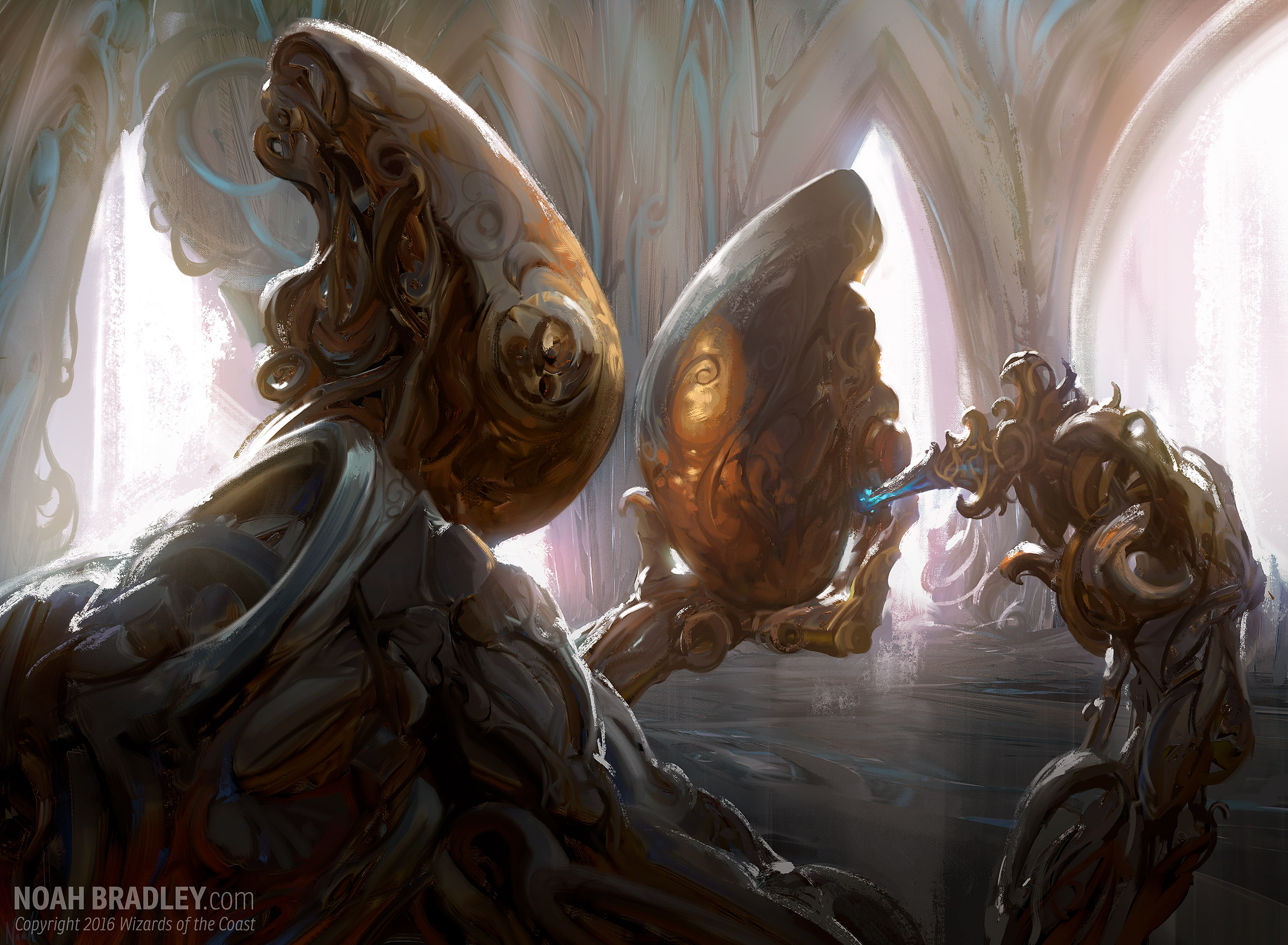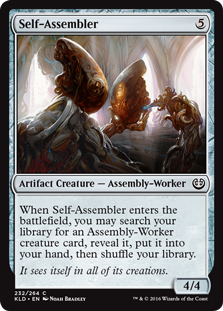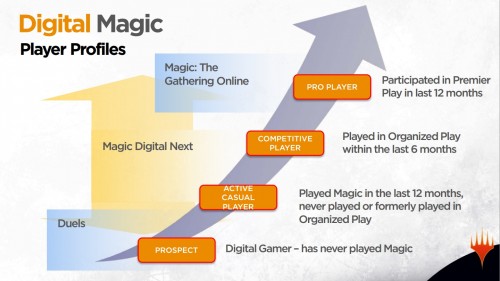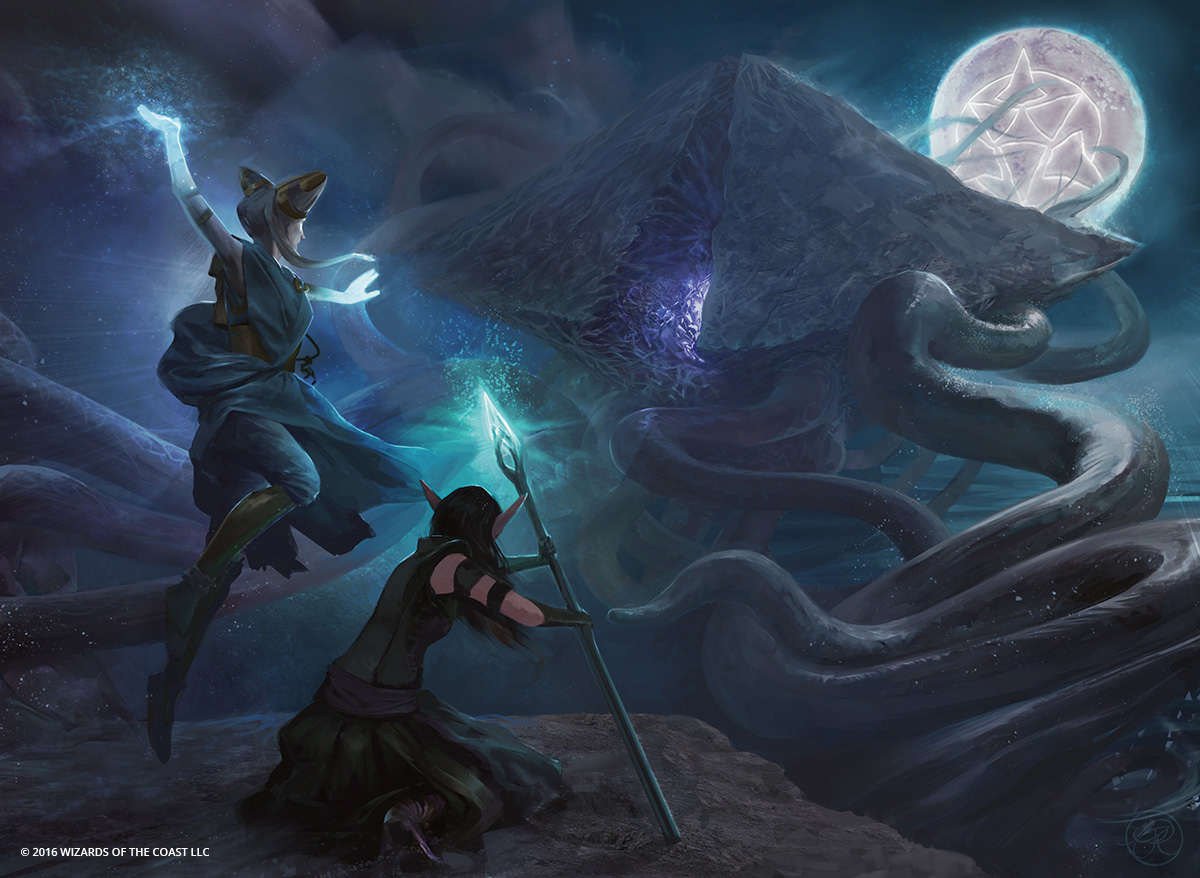Today's post was delayed by some gateway errors over at pdcmagic.com, but I'm happy to report that those have been resolved. I have also resumed my Standard Pauper Deck Techs, and I should have the first installment up on Monday. But for today, I want to take a look at the twelve decks that made it to the playoffs of our two Standard Pauper events and offer a snapshot of the current metagame.
Gone entirely was the Gruul Thriving deck that performed so well last week. Instead, the archetype to beat this week is a return of the Izzet Spells deck, which earned a Top 4 finish in SPDC and two Top 8 finishers in MPDC. This build is very similar to the one that dominated last season, but adds Self-Assembler and Tezzeret's Ambition to the mix.
Another archetype that performed well was an Esper Auras deck. This deck is all about Artifacts and Enchantments, utilizing Ironclad Slayer and Aviary Mechanic to recur strong cards like Boon of Emrakul, Dead Weight, Prophetic Prism, and Self-Assembler, while backing up those threats with a strong removal suite. GotThisForSOI piloted this archetype to first place in MPDC as well as a Top 4 finish in SPDC.
These two archetypes were the only ones to have multiple representatives among the playoffs of the two events, with 8 other unique decks filling the remaining slots.
Among these was a Sultai Control build by rremedio1 that took the trophy in SPDC which relies upon the sacrifice synergies of Primal Druid, Wretched Gryff, Bloodbriar, Bone Splinters, and Altar's Reap to generate a ton of card advantage, backed up by powerful Pulse of Murasa as well as the new powerhouse of the format Self-Assembler.
The rest of the pack included a Mono Black Vehicles deck, a repeat of the Rakdos Madness deck that performed well last week, a Dimir Control build, a Boros Vehicles deck, a Simic Big Stuff deck that was also featured last time, and a Mono Blue Control build. Of these, only two didn't include a full playset of Self-Assembler, which as I mentioned earlier this week has quickly become the card to beat in Standard Pauper.
Yet despite the prominence of that single card, the metagame is still quite diverse, with 10 different decks among the top performers. Perhaps that will be the saving grace of the format, since almost any deck can take advantage of this card without constraining the deck in any particular direction. This will certainly be something to watch moving forward.
See you next time.
Saturday, October 29, 2016
Tuesday, October 25, 2016
Self-Assembler
Back in my set review of Kaladesh for Standard Pauper, I rated Self-Assembler as being among the best cards in Kaladesh and predicted that it was likely to make a major impact on the format. And as I might have predicted, this week I already heard one player requested that this card be banned, with the rationale that the card was being included in every deck and that each game seemed to come down to whomever drew this card first. While calling for such drastic action with only a couple weeks behind us is a bit premature, it's hard to fault these claims. Let's take a quick look at the card.
This card immediately brings to mind Squadron Hawk, an innocent looking Common from Magic 2011 that also fetched another copy of itself when it entered the battlefield. But this card is clearly much better than that. First, for only three more mana, you're getting a 4/4 rather than a 1/1 Flyer, which is clearly more relevant most of the time. Second, since this is a Colorless artifact, it can be played in any deck, and has additional synergies in the format. Third, while a vanilla 4/4 for 5 wouldn't normally make the cut in the format, it's still close enough to a full card in value to make drawing three additional copies of it over multiple turns very strong. In fact, it's a virtual three-for-one with the only drawback being you have to cast each one before you get access to the next one.
Unlike in Standard, our format doesn't include any means of dealing with multiple creatures at once beyond tokens, and also doesn't give you any means of removing your opponent's ability to play them. Really, the only answer in the format that doesn't involve massive card disadvantage is to counter the first one when it comes up, hopefully granting you enough time to finish off your opponent before he or she can draw the next one. Self-Assembler is almost always going to at least trade with any creature on the board, which means you don't really have any chance of holding it back with bigger creatures. So if you can't counter it, you're only other option is to race it, knocking your opponent down to zero before they can leverage the advantage gained from this card.
All that said, if you're not including this card in any deck that isn't super aggressive, you're probably making a mistake.
This card immediately brings to mind Squadron Hawk, an innocent looking Common from Magic 2011 that also fetched another copy of itself when it entered the battlefield. But this card is clearly much better than that. First, for only three more mana, you're getting a 4/4 rather than a 1/1 Flyer, which is clearly more relevant most of the time. Second, since this is a Colorless artifact, it can be played in any deck, and has additional synergies in the format. Third, while a vanilla 4/4 for 5 wouldn't normally make the cut in the format, it's still close enough to a full card in value to make drawing three additional copies of it over multiple turns very strong. In fact, it's a virtual three-for-one with the only drawback being you have to cast each one before you get access to the next one.
Unlike in Standard, our format doesn't include any means of dealing with multiple creatures at once beyond tokens, and also doesn't give you any means of removing your opponent's ability to play them. Really, the only answer in the format that doesn't involve massive card disadvantage is to counter the first one when it comes up, hopefully granting you enough time to finish off your opponent before he or she can draw the next one. Self-Assembler is almost always going to at least trade with any creature on the board, which means you don't really have any chance of holding it back with bigger creatures. So if you can't counter it, you're only other option is to race it, knocking your opponent down to zero before they can leverage the advantage gained from this card.
All that said, if you're not including this card in any deck that isn't super aggressive, you're probably making a mistake.
Thursday, October 20, 2016
The Week of October 16th in Standard Pauper
Hard to believe it's been a month already since my last metagame update for Standard Pauper! But this week marked the return of both of our Standard Pauper Player Run Events, with twelve brand new decks that made the cut to the playoffs between them. With the rotation of both Dragons of Tarkir and Magic Origins and the release of Kaladesh, things are obviously going to look very different. That being the case, I suspect it will take several weeks for the best decks to emerge. But with that said, let's go ahead and take a look at the top performers from this week's tournaments.
Three archetypes earned multiple finishes among the two events. The first was a Gruul colored Thriving deck, nicknamed for its two Thriving creatures Peema Outrider and Riparian Tiger, who joined forces with the Landfall enabled Snapping Gnarlid and Valakut Predator to create quite the beatdown deck. This archetype took 1st place in SPDC and a Top 8 finish in MPDC.
The second archetype was a Rakdos Madness deck that plays off the synergy between Madness cards and Tormenting Voice (and its Kaladesh equivalent Cathartic Reunion), backing them up with a varied suite of removal and solid creatures. This archetype earned a second place finish in both events as well as another Top 8 finish in MPDC.
The third archetype was what I have termed a Simic Big Stuff deck. This is essentially a revamp of the Simic Eldrazi deck that performed so well last season, but with the key addition of Self-Assembler and Vehicles instead of some of the Eldrazi fatties. This archetype took both 1st place and Top 8 in MPDC.
The rest of the field was an Esper Midrange deck, a stock Orzhov Allies from last season, an almost unchanged Izzet Spells deck, a Stompy deck, and MonoBlack Vehicles.
Among all these decks, the big winners from Kaladesh appear to be Peema Outrider, Renegade Freighter, Self-Assembler, and Thriving Rhino. If you're playing a deck that includes three or four of these cards, you're probably going to do alright moving forward! It will certainly be interesting to see how these cards continue to impact the metagame going forward.
Three archetypes earned multiple finishes among the two events. The first was a Gruul colored Thriving deck, nicknamed for its two Thriving creatures Peema Outrider and Riparian Tiger, who joined forces with the Landfall enabled Snapping Gnarlid and Valakut Predator to create quite the beatdown deck. This archetype took 1st place in SPDC and a Top 8 finish in MPDC.
The second archetype was a Rakdos Madness deck that plays off the synergy between Madness cards and Tormenting Voice (and its Kaladesh equivalent Cathartic Reunion), backing them up with a varied suite of removal and solid creatures. This archetype earned a second place finish in both events as well as another Top 8 finish in MPDC.
The third archetype was what I have termed a Simic Big Stuff deck. This is essentially a revamp of the Simic Eldrazi deck that performed so well last season, but with the key addition of Self-Assembler and Vehicles instead of some of the Eldrazi fatties. This archetype took both 1st place and Top 8 in MPDC.
The rest of the field was an Esper Midrange deck, a stock Orzhov Allies from last season, an almost unchanged Izzet Spells deck, a Stompy deck, and MonoBlack Vehicles.
Among all these decks, the big winners from Kaladesh appear to be Peema Outrider, Renegade Freighter, Self-Assembler, and Thriving Rhino. If you're playing a deck that includes three or four of these cards, you're probably going to do alright moving forward! It will certainly be interesting to see how these cards continue to impact the metagame going forward.
Tuesday, October 18, 2016
Magic Digital Next
Yesterday my good friend joekewwl tipped me off to the fact that Wizards of the Coast is somewhere in process of creating a brand new Magic the Gathering digital initiative. He referenced this article published earlier this year, which in turn is based on a press release from Hasbro. joekewwl also mentioned that this project, which is referred to as Magic Digital Next, may already be looking for a select group of players to playtest this at some point in the future.
As you can see from the above graphic, this new digital project would be geared for casual and competitive players looking for a well polished digital experience but that isn't quite as all encompassing as Magic Online. The article states that this is no doubt driven by the success of Hearthstone, which is streamed around the clock, available on just about every platform, and has a very successful e-sport franchise. Furthermore,
"while the paper version of Magic may be doing better than ever before, its digital offerings are weirdly split between two products which at best are kinda-sorta OK. Magic Duels is their free to play side which is largely targeted towards players new to the game, but judging by reactions of hardcore Magic players, many of the restrictions the game has keeps them from getting invested. Meanwhile, Magic Online exists in a constant state of jank and inexplicably is only available for the PC."
I for one would love to see Wizards of the Coast actually launch a well-polished and competitive digital product that could be favorable compared to games like Sol Forge, Hearthstone, or Eternal. Unfortunately, Wizards has a proven track record of bad decisions when it comes to digital offerings, so unless Hasbro is willing to make a significant investment in such a product, I feel that any such new game may come as too little too late.
As you can see from the above graphic, this new digital project would be geared for casual and competitive players looking for a well polished digital experience but that isn't quite as all encompassing as Magic Online. The article states that this is no doubt driven by the success of Hearthstone, which is streamed around the clock, available on just about every platform, and has a very successful e-sport franchise. Furthermore,
"while the paper version of Magic may be doing better than ever before, its digital offerings are weirdly split between two products which at best are kinda-sorta OK. Magic Duels is their free to play side which is largely targeted towards players new to the game, but judging by reactions of hardcore Magic players, many of the restrictions the game has keeps them from getting invested. Meanwhile, Magic Online exists in a constant state of jank and inexplicably is only available for the PC."
I for one would love to see Wizards of the Coast actually launch a well-polished and competitive digital product that could be favorable compared to games like Sol Forge, Hearthstone, or Eternal. Unfortunately, Wizards has a proven track record of bad decisions when it comes to digital offerings, so unless Hasbro is willing to make a significant investment in such a product, I feel that any such new game may come as too little too late.
Thursday, October 13, 2016
Playing RPGs with Cards Instead of Dice
This week I came across a fascinating new twist to bring to your roleplaying game - use playing cards instead of dice. While I encourage you to check out the original article linked above, the basic idea is that you deal out a card array of 12 cards to be shared among the players as well as a hand of 5 cards that the GM keeps concealed in his hand. Then, any time that a roll is required from the players, they instead pick a card from the array in front of them and use that result instead. That player then draws a new card and adds it to the array.
However, the card that was just played isn't discarded. Instead, that player hands it to the GM, who adds it to his own hand of cards. Whenever the GM would normally roll a dice, he or she also picks a card in hand, plays it, and then discards it into the discard pile, where it will eventually be shuffled back in once the entire draw pile has been used up. The GM is also limited to only twelve cards in hand.
This obviously creates some interesting tension for the players. While they are free to use their highest cards to guarantee success, they are also giving the GM that same ability.
Now obviously you have to do some adjustments depending on the game system you're using, especially if you also include the face cards in the mix. For D&D or other games that resolve around a d20, the simplest solution (and the one advocated in the original post) is to use red cards for their face value (with aces counting as a one) and black cards as being worth ten plus their face value. The author also has the following rules for face cards:
I love the tactical strategies and considerations that this opens up for players and can't wait to try this out with my own gaming group. Thanks to Run A Game for such a great idea!
However, the card that was just played isn't discarded. Instead, that player hands it to the GM, who adds it to his own hand of cards. Whenever the GM would normally roll a dice, he or she also picks a card in hand, plays it, and then discards it into the discard pile, where it will eventually be shuffled back in once the entire draw pile has been used up. The GM is also limited to only twelve cards in hand.
This obviously creates some interesting tension for the players. While they are free to use their highest cards to guarantee success, they are also giving the GM that same ability.
Now obviously you have to do some adjustments depending on the game system you're using, especially if you also include the face cards in the mix. For D&D or other games that resolve around a d20, the simplest solution (and the one advocated in the original post) is to use red cards for their face value (with aces counting as a one) and black cards as being worth ten plus their face value. The author also has the following rules for face cards:
- King: Succeed at cost. You automatically succeed, but some complication, error, or unintended consequence is introduced by the GM. After playing a King, do not give it to the GM. Place it in the players' discard pile directly to be shuffled back in if .
- Queen: Failure, gain 1 treasure, placing the Queen in the score pile for the rest of the session.
- Jack: Failure, gain 1 experience, placing the Jack in the score pile for the rest of the session.
- Joker: Critical failure, gain 1 experience and 1 treasure. The GM describes how your action went horribly wrong or caused additional foul consequences. Place the Joker in the score pile for the rest of the session.
I love the tactical strategies and considerations that this opens up for players and can't wait to try this out with my own gaming group. Thanks to Run A Game for such a great idea!
Tuesday, October 11, 2016
More Eternal
As I mentioned back at the end of August, I had the opportunity to join the closed beta for Eternal, a brand new digital card game by Dire Wolf Digital. Since then I have played a ton of it, and probably spent a similar amount of time watching videos and reading articles about this brand new game. If you haven't seen or heard anything about this game, its being designed and developed by some of the best Magic the Gathering
pros, including Luis Scott-Vargas, Conley Woods, and Patrick Chapin, just to name a few. Needless to say, it comes highly recommended.
It is still in closed beta, but the company seems to be pretty generous in distributing new beta keys. In addition, close beta will soon be coming to an end soon, and then the game will be available to the general public.
But even while it's still in beta, there's already a ton of content already available. Today I want to highlight the work of two of this fledgling community's best: aReNGee and Sir_Rhino.
It is still in closed beta, but the company seems to be pretty generous in distributing new beta keys. In addition, close beta will soon be coming to an end soon, and then the game will be available to the general public.
But even while it's still in beta, there's already a ton of content already available. Today I want to highlight the work of two of this fledgling community's best: aReNGee and Sir_Rhino.
- aReNGee has created a great website with articles, draft pick orders, and a frequently updated metagame summary. He also has a YouTube channel where you can watch him play.
- Sir_Rhino is a very active streamer on Twitch, and you can view all of his past videos on his channel. In addition, he is also a frequent guest on a podcast called Eternal Cast, where he, aReNGee, and the host Neon have done a full set review of the cards for draft. This is a great resource for getting up to speed with all of the cards and their power level in the current environment.
Thursday, October 6, 2016
Presenting the Champions of Season 32
This past week we had the capstone events for this season of both SPDC and MPDC, generally referred to as our WORLDS event. Although the rotation of Standard means that a lot of this past season's metagame won't be directly relevant, I still thought it was worth taking one last look by highlighting the two champions from our WORLDS events. Storm_blade took the trophy in SPDC with his Simic Eldrazi deck, while rremedio1 took the trophy in MPDC with a 4 color Sultai Control deck. Let's take a look at their lists:
The strategy of this deck is to play lots of early creatures like Elvish Visionary and Primal Druid, generate mana ramp via the Eldrazi Scions from Eldrazi Skyspawner and Scion Summoner, then leverage all that mana to Emerge either It of the Horrid Swarm or Wretched Gryff, or simply power out the Eldrazi Devastator to overwhelm your opponent. It's mostly a creature-based deck, but it does have a smidgen of removal with Epic Confrontation. It also plays Pulse of Murasa (and Monastery Loremaster as a virtual fifth copy) to keep itself alive and recur its creatures, a couple Might of the Masses to give it an additional angle to win, and a Cathar's Shield to help protect its best creatures from burn-based removal.
rremedio1's build relies on a surprisingly similar base of creatures, but having access to Black gives the deck access to a whole host of powerful removal spells like Reave Soul, Oblivion Strike, and Complete Disregard, as well as generating even more sacrifice synergy with the excellent Vulturous Aven. Rather than the big Eldrazi, rremedio instead chose Ruin Processor, which serves a similar role but also sometimes gives you an important boost of Life as well. Brilliant Spectrum is probably the most surprisingly card in the deck, but when you have access to four colors, it becomes quite strong. Finally, it's worth noting that in order to support all those colors, the deck runs two Pilgrim's Eyes as well as Holdout Settlement and Unknown Shores.
Congrats to both Storm_blade and rremedio1 on their victories! I personally can't wait to see what the new format has in store once Kaladesh is released on Magic Online - which, if I recall correctly, starts today!
Simic Eldrazi
SPDC 34 Champion Storm_blade
| Creatures 4 Eldrazi Skyspawner 4 Elvish Visionary 4 It of the Horrid Swarm 4 Primal Druid 4 Scion Summoner 4 Wretched Gryff 1 Monastery Loremaster 2 Eldrazi Devastator 27 cards Other Spells 4 Epic Confrontation 4 Pulse of Murasa 2 Might of the Masses 1 Cathar's Shield 11 cards |
Lands 11 Forest 11 Island 22 cards
Sideboard
3 Negate 3 Root Out 2 Deny Existence 2 Drag Under 2 Dispel 2 Rabid Bite 1 Bone Saw 15 cards |
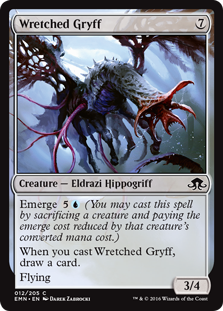
|
The strategy of this deck is to play lots of early creatures like Elvish Visionary and Primal Druid, generate mana ramp via the Eldrazi Scions from Eldrazi Skyspawner and Scion Summoner, then leverage all that mana to Emerge either It of the Horrid Swarm or Wretched Gryff, or simply power out the Eldrazi Devastator to overwhelm your opponent. It's mostly a creature-based deck, but it does have a smidgen of removal with Epic Confrontation. It also plays Pulse of Murasa (and Monastery Loremaster as a virtual fifth copy) to keep itself alive and recur its creatures, a couple Might of the Masses to give it an additional angle to win, and a Cathar's Shield to help protect its best creatures from burn-based removal.
Sultai Worlds
MPDC 34 Champion rremedio1
| Creatures 4 Elvish Visionary 3 Primal Druid 3 Vulturous Aven 3 Wretched Gryff 2 Eldrazi Skyspawner 2 Pilgrim's Eye 2 Ruin Processor 1 Dutiful Attendant 1 Monastery Loremaster 20 cards Other Spells 4 Pulse of Murasa 4 Reave Soul 3 Oblivion Strike 2 Brilliant Spectrum 2 Complete Disregard 1 Rolling Thunder 17 cards |
Lands 5 Forest 4 Evolving Wilds 4 Island 4 Swamp 3 Holdout Settlement 2 Unknown Shores 1 Mountain 23 cards
Sideboard
3 Boiling Earth 3 Negate 2 Natural State 1 Caustic Caterpillar 1 Drag Under 1 Duress 1 Monastery Loremaster 1 Roilmage's Trick 1 Rolling Thunder 1 Ruin Processor 15 cards |
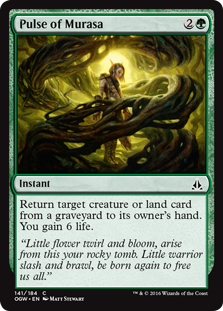
|
rremedio1's build relies on a surprisingly similar base of creatures, but having access to Black gives the deck access to a whole host of powerful removal spells like Reave Soul, Oblivion Strike, and Complete Disregard, as well as generating even more sacrifice synergy with the excellent Vulturous Aven. Rather than the big Eldrazi, rremedio instead chose Ruin Processor, which serves a similar role but also sometimes gives you an important boost of Life as well. Brilliant Spectrum is probably the most surprisingly card in the deck, but when you have access to four colors, it becomes quite strong. Finally, it's worth noting that in order to support all those colors, the deck runs two Pilgrim's Eyes as well as Holdout Settlement and Unknown Shores.
Congrats to both Storm_blade and rremedio1 on their victories! I personally can't wait to see what the new format has in store once Kaladesh is released on Magic Online - which, if I recall correctly, starts today!
Tuesday, October 4, 2016
Isle of Skye
One of the great new games I got to playtest this year at GenCon is a board game called Isle of Skye: From Chieftain to King. In this game, you take on the role of one of five chieftains seeking to grow your kingdom and accumulate the most victory points at the end of the game. You do this by placing tiles that you either randomly select or purchase from the other players and arranging those tiles to maximize your score based upon four victory conditions randomly selected for each game.
The most interesting part of the game isn't placing your tiles though. Rather, each round you randomly draw three tiles from the bag. Then, each player secretly decides to discard one tile and set a price on the other two. Once every one has made their choices, you all reveal them, and starting with the player whose turn it is, you can choose to buy one of the tiles from another player at the price he or she has selected. And here's where things get interesting.
Price your tile too low, and your opponent gets a valuable tile that they may be able to score with over multiple rounds. But price your tile too high, and not only do you not get any income when no one buys it, but you also have to pay that money to keep the tile for yourself. Furthermore, based on the way the buying works, it's possible that all of your tiles get purchased, leaving you with just one new one, while your opponent each place two tiles that round. Of course, most of the time the quality of your tiles is much more important than the quantity - but still, that's not typically a winning strategy.
The game is played over five rounds, with only one or two of the victory conditions actually scoring for that round. If you find yourself falling behind in points, after round two you do earn some additional funds to help you catch up. While these funds can be converted into points at the end of the game, ultimately they are a pretty poor source of points, so in practice this doesn't always balance the scales as much as you might think.
The components of the game are beautifully illustrated and solid craftsmanship. The markings on the tiles are easy to identify, and the different victory conditions do a solid job of demonstrating exactly what counts for points for that condition without making you consult the rulebook to read how they work. Speaking of which, the rulebook is short and sweet, and you probably won't need more than 15 minutes or so to teach a new player how to play.
Overall I enjoyed this game very much. This is a great example of a game that is simple to learn and play, but has a surprisingly level of depth as you get into it. The game comes with a good selection of different win conditions and a huge bag of tiles, so there's a lot of replay value. Additionally, from my experience, the game plays quite well with anywhere from 2-5 players. If you like tile-placement games or are looking for a simple but also subtly complex game, definitely give Isle of Skye a try!
The most interesting part of the game isn't placing your tiles though. Rather, each round you randomly draw three tiles from the bag. Then, each player secretly decides to discard one tile and set a price on the other two. Once every one has made their choices, you all reveal them, and starting with the player whose turn it is, you can choose to buy one of the tiles from another player at the price he or she has selected. And here's where things get interesting.
Price your tile too low, and your opponent gets a valuable tile that they may be able to score with over multiple rounds. But price your tile too high, and not only do you not get any income when no one buys it, but you also have to pay that money to keep the tile for yourself. Furthermore, based on the way the buying works, it's possible that all of your tiles get purchased, leaving you with just one new one, while your opponent each place two tiles that round. Of course, most of the time the quality of your tiles is much more important than the quantity - but still, that's not typically a winning strategy.
The game is played over five rounds, with only one or two of the victory conditions actually scoring for that round. If you find yourself falling behind in points, after round two you do earn some additional funds to help you catch up. While these funds can be converted into points at the end of the game, ultimately they are a pretty poor source of points, so in practice this doesn't always balance the scales as much as you might think.
The components of the game are beautifully illustrated and solid craftsmanship. The markings on the tiles are easy to identify, and the different victory conditions do a solid job of demonstrating exactly what counts for points for that condition without making you consult the rulebook to read how they work. Speaking of which, the rulebook is short and sweet, and you probably won't need more than 15 minutes or so to teach a new player how to play.
Overall I enjoyed this game very much. This is a great example of a game that is simple to learn and play, but has a surprisingly level of depth as you get into it. The game comes with a good selection of different win conditions and a huge bag of tiles, so there's a lot of replay value. Additionally, from my experience, the game plays quite well with anywhere from 2-5 players. If you like tile-placement games or are looking for a simple but also subtly complex game, definitely give Isle of Skye a try!
Subscribe to:
Posts (Atom)

